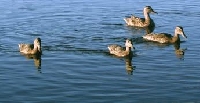
 |
 |
 |
 |
 |
 |
Duck and Waterfowl Habits
 Ducks and most waterfowl eat insects, snails, frogs, and fish. They also feed on grains, grasses, and other kinds of plant life.
Ducks and most waterfowl eat insects, snails, frogs, and fish. They also feed on grains, grasses, and other kinds of plant life.
The mother ducks lay from six to perhaps sixteen eggs in a warm nest made of leaves, dry grass, and other materials. Sometimes two ducks lay eggs in the same nest. The nest is lined with down which the mother duck takes from her own breast. Nests are usually built on the ground near the water. Sometimes they are placed in a bushy field farther back. Some kinds of ducks may build their nests in hollow trees. The mother takes care of the family. For three or four weeks she remains almost constantly on the nest. The ducklings are covered with down when they break through their shell. The mother leads them to water as soon as they can travel. The ducklings cannot fly for six weeks or more after they are hatched. They must be carefully guarded by the mother.
When the ducklings are young, all the adult ducks shed many of their old, worn, and ragged feathers. The adult ducks cannot fly until strong, new feathers grow in.
The male ducks usually have more brilliant feathers than the females. When they shed their feathers in the summer, however, they become covered with an eclipse {dull} plumage. At this time they look more like the drab females.
Ducks often live together in large flocks. Some of them travel north in the spring, and south in the fall. Many of them are shop by hunters during the southward flight. Duck hunting season takes a large toll on the population.
Resources
| Other Resources
| Land for Sale/Lease

Alaska
Arizona
Arkansas
California
Colorado
Connecticut
Delaware
Florida
Georgia
Hawaii
Idaho
Illinois
Indiana
Iowa
Kansas
Kentucky
Louisiana
Maine
Maryland
Massachusetts
Michigan
Minnesota
Mississippi
Missouri
Montana
Nebraska
Nevada
New Hampshire
New Jersey
New Mexico
New York
North Carolina
North Dakota
Ohio
Oklahoma
Oregon
Pennsylvania
Rhode Island
South Carolina
South Dakota
Tennessee
Texas
Utah
Vermont
Virginia
Washington
West Virginia
Wisconsin
Wyoming
Hunting Trips in
Other Countries
Canada
The eating and living habits of the duck may help you understand what to keep in mind when hunting this waterfowl bird.